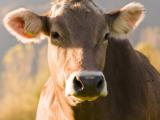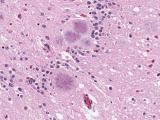Dec 30, 2004 (CIDRAP News) US officials announced plans yesterday to end the ban on the importation of live Canadian cattle that was imposed when Canada discovered its first case of bovine spongiform encephalopathy (BSE) in May 2003.
The US Department of Agriculture (USDA) said the borders will be reopened to live cattle less than 30 months of age and certain other products starting Mar 7. BSE, or mad cow disease, has very rarely been found in cattle younger than 30 months. The decision was based on a determination that Canada is a "minimal risk region" for BSE.
"After conducting an extensive review, we are confident that imports of certain commodities from regions of minimal risk can occur with virtually no risk to human or animal health," US Agriculture Secretary Ann Veneman said in a news release.
Ironically, yesterday's USDA announcement was followed today by a Canadian announcement of a suspected case of BSE in a 10-year-old dairy cow. Results of confirmatory tests on the cow were expected in 3 to 5 days (see link below for separate story). Today USDA officials said they remain confident that Canada's BSE-prevention program is sound.
If BSE were confirmed in the Canadian cow, "It would not alter the implementation of the U.S. rule announced yesterday that recognizes Canada as a Minimal-Risk Region," Dr. Ron DeHaven, head of the USDA Animal and Plant Health Inspection Service, said in a statement.
In considering whether to reopen the borders, the USDA considered the possibility of more cases of BSE in Canada, DeHaven said. "Because of the mitigation measures that Canada has in place, we continue to believe the risk is minimal."
Live Canadian cattle will be allowed into the United States only under restrictions designed to ensure that they are slaughtered by the time they reach 30 months of age, the USDA said. The cattle will have to bear permanent marks indicating their origin and must be transported in sealed containers to a feedlot or to slaughter. Moving cattle to more than one feedlot in the United States will be prohibited.
The USDA rule announced yesterday also sets conditions for the importation of sheep, goats, cervids (deer and elk), and llamas, as well as meat and other products derived from them. The 500-page rule will be published in the Federal Register Jan 4 and will take effect Mar 7, the agency said.
Before the ban on Canadian cattle, the United States bought about 70% of Canada's live cattle exports, according to an Associated Press (AP) report today. The New York Times cited a prediction from USDA officials that American feedlots would import 2 million cattle from Canada in 2005, which could lower beef prices for American consumers.
When Canada reported its first BSE case in an Alberta cow in May 2003, the United States immediately banned importation of all cattle, beef, and related products from Canada. In August 2003, the USDA lifted the ban on boneless meat from cattle less than 30 months old as well as a few other products from cattle, sheep, and goats.
The USDA first proposed to lift the ban on young Canadian cattle in November 2003. The discovery of the first US case of BSE, in a Canadian-born cow in Washington state in December 2003, prompted the agency to extend the public comment period on that proposal until April of this year. The plan unveiled yesterday appears similar to the proposal presented in November 2003.
The USDA cited several Canadian BSE safeguards that helped justify the conclusion that the risk of BSE in Canadian cattle is low:
- A ban on the use of "specified risk materials" (SRM) in human food. SRM include tissues such as the brain, spinal cord, certain nerve bundles, small intestine, and tonsils, which are likely to carry the BSE agent in an infected animal. (The United States imposed a similar ban on using SRM in human food after its first BSE case was discovered in December 2003.)
- Import restrictions that minimize exposure to BSE. Since 1990 Canada has banned live ruminants and ruminant products, including rendered protein, from countries that have found BSE in native cattle or are considered to be at significant risk for BSE.
- Surveillance for BSE at levels that have met or exceeded international guidelines for at least the past 7 years
- A ban on feeding ruminant protein to ruminants since 1997 (the same year the United States imposed a similar ban)
- "Appropriate epidemiological investigations, risk assessment, and risk mitigation measures imposed as necessary"
Even though a renewed flow of Canadian cattle could lower beef prices in the United States, the National Cattlemen's Beef Association (NCBA) welcomed the USDA announcement. NCBA President Jan Lyons said the US beef industry, which lost export markets after the American BSE case was found a year ago, should benefit from the move in the long run.
"We expect our trading partners to base their decisions to trade with us on science, and we must do the same," Lyons stated. "The precedent that has been set by our handling of trade issues with Canada is hurting our government's ability to fully reopen markets to U.S. beef exports. We must normalize trade with Canada in order for our industry to move forward in the global marketplace, expand our ability to sell U.S. beef to foreign consumers, and put more dollars in the pockets of U.S. producers."
See also:
Dec 30 statement by AHIS Administrator Ron DeHaven
Transcript of Dec 29 USDA news briefing
CIDRAP News story on the report of a suspected BSE case in Canada















